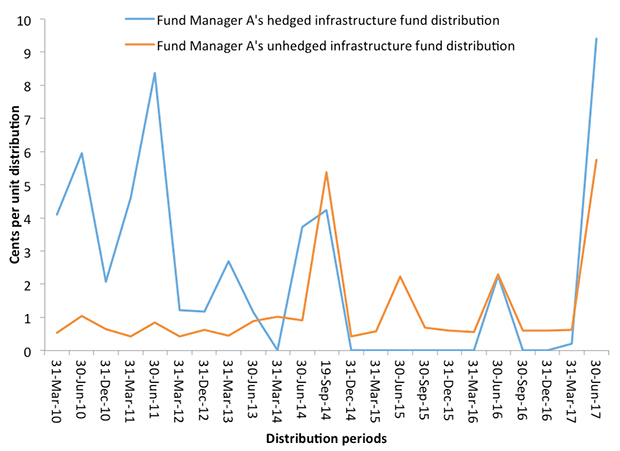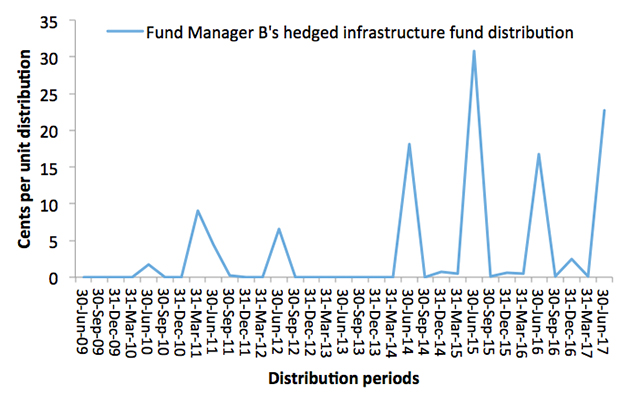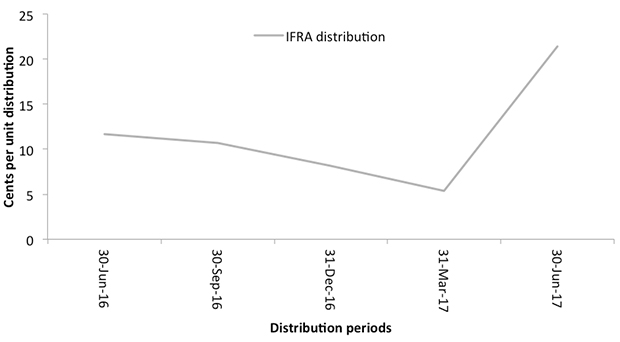Do you like your income smooth or crunchy?
A lot of investors like their portfolio to deliver a smooth series of payments into their bank account. That’s easy to do if you settle for low paying bank accounts but it gets much harder when you need higher returns. A common solution is to include infrastructure investments in the portfolio, but those who have chosen the wrong infrastructure fund have been disappointed.
Infrastructure Securities
Infrastructure securities were introduced to the Australian investing public as a way of getting decent returns, including an income yield, with less of the wild fluctuations of traditional equities.
It has turned out that listed infrastructure securities still go up and down as the market goes up and down. They also have their own cycle of high demand and low demand. So there is still some volatility but there is also some core stability to the earnings that most equities don’t have.
Infrastructure securities are investments in assets like roads, ports and power stations. These are long-lived assets with high barriers to entry and robust demand for their use. Of most interest to investors is that there is often some sort of indirect government support such as regulated pricing that ensures the securities’ revenue increases in line with inflation.
The distributions from these infrastructure securities are not smooth when compared to term deposits but they can be much smoother than a typical portfolio of equities.
There are a number of securities listed on ASX with direct investment in infrastructure assets but there are not enough of them to make up a properly diversified infrastructure portfolio. The likes of Transurban and Sydney Airport are good at what they do but to achieve well-diversified exposure to infrastructure you need broader exposure than just Australian roads and Australian airports.
You want your investments spread around the globe. You could include major international airports such as Zurich, owned by Flughafen Zürich AG, and the Guangzhou-Shenzhen Superhighway, part of Hopewell Highway Infrastructure Limited, based in Hong Kong. You also want different types of assets, like mobile phone towers and satellites via companies like American Tower Corporation and SES S.A. based in Luxembourg.
For proper diversification you need a fund of global infrastructure securities. There are a number of such funds available and investors make good use of them. There are two mistakes though that have disappointed some investors who have expected smoother income: ignoring currency risk and the tax rules.
Mistake #1: Currency Risk
The first mistake is to overlook the fact that offshore infrastructure securities expose investors to currency risk. There is a big difference between a fund that hedges the currency risk and one that doesn’t. Some investors are happy to take currency risk. When the currencies move favourably returns from the fund can be very high. But it is a wild ride and unpleasant for those who want smooth income. The distributions can be very high or they can disappear completely.
Mistake #2: The Tax Rules
The second mistake takes us to the arcane and baffling world of income tax. Even investors in hedged infrastructure funds have had the bad experience of periods of very high distributions mixed with long periods of no distributions at all. Here is an example from a widely regarded fund manager. Their hedged fund is even more volatile than their unhedged fund. Note that the hedged fund made no distributions between September 2014 and 30 June 2016 nor did they pay out a distribution in two quarters last year.

Source: Fund Manager A’s website1 accessed 20 July 2017. Past performance is not a reliable indicator of future performance.
Here is another example, also from a widely regarded fund manager. Note how many quarters had a zero distribution.

Source: Fund Manager B’s website1 accessed 20 July 2017. Past performance is not a reliable indicator of future performance.
You can understand how the unhedged funds get tossed about by the volatile currency markets but the point of hedging is to remove this effect. Hedging is supposed to restore the underlying income to its relatively smooth pattern.
The lesson is that currency hedging is just one of two necessary steps in maintaining the smoothness of the income stream. It is not obvious that this is a tax problem. An esoteric part of the income tax law, understood by just a few boffins, however turns out to be the answer.
The solution starts with the obscure fact that fund distributions have to be calculated using the rules of income tax. Companies can declare as a dividend any round number they want. Companies can therefore choose a smooth pattern for their payments. On the other hand, funds such as infrastructure funds, have to distribute all of the income they receive. The underlying reason for this is to do with overcoming tax deferral but that’s a complicated story for another time. The important point in this context is that funds are forced to follow a very large set of opaque rules.
One of the opaque rules that vexes most hedged infrastructure funds is about the timing of recording the profits and losses on the currency hedges. The key point to understand is that there is a big discrepancy between the timing rule for currency hedges and the timing rule for the assets being hedged. That discrepancy is the source of the problem.
The Government did address this problem as part of the reforms known as the ‘Taxation of Financial Arrangements’, which are known affectionately by the boffins as ‘ToFA’.
ToFA allows the rules for the hedges to match the rules for the hedged assets. Unfortunately for investors, ToFA is so difficult to implement that most managers of infrastructure funds simply don’t use it.
Where that leaves those investors who are looking for smooth income from infrastructure is having to ask two questions before choosing an infrastructure fund:
- is the currency hedged? and
- does it use the ToFA rules?
There aren’t many funds that can answer yes to both questions.
VanEck’s Global Infrastructure ETF
The VanEck Vectors FTSE Global Infrastructure (Hedged) ETF (ASX Code: IFRA) is an exchange traded fund with a portfolio of about 150 infrastructure securities from around the world, including all six securities named above.
This ETF is hedged and VanEck has its own boffins who implement the ToFA rules in this fund. This is one of the few infrastructure funds that can pay to investors the relatively smooth returns generated by the underlying securities.
Infrastructure investors cannot have too high an expectation of how smooth the payments from a fund like this are going to be. Compared to unhedged funds and hedged funds that don’t use ToFA, however this fund’s distributions have been relatively smooth. There have been no periods in which a distribution has not been paid nor are there any spikes which astound.

Source: VanEck. Inception date of IFRA is 29 April 2017. Past performance is not a reliable indicator of future performance.
This ETF was only launched on 3 May 2016. The 2017 financial year was its first full year and the fund grew rapidly during this early period. It is a feature of investment funds that during a growth phase distributions get diluted as the quarter’s income gets split between all unitholders in the ETF at the end of the quarter even though the capital from the newer investors was only earning income for part of that quarter. As a fund gets bigger, new investors are a smaller proportion of the total and the effect diminishes.
If you like your income smooth rather than crunchy and are interested in the benefits of infrastructure securities, IFRA is one of the few funds that you should consider.
IMPORTANT NOTICE: This information is issued by VanEck Investments Limited ABN 22 146 596 116 AFSL 416755 (‘VanEck’) as responsible entity and issuer of the VanEck Vectors FTSE Global Infrastructure (Hedged) ETF (‘Fund’). Nothing in this content is a solicitation to buy or an offer to sell shares of any investment in any jurisdiction including where the offer or solicitation would be unlawful under the securities laws of such jurisdiction. This is general information only and not financial advice. It does not take into account any person’s individual objectives, financial situation or needs. Before making an investment decision in relation to the Fund, you should read the PDS and with the assistance of a financial adviser consider if it is appropriate for your circumstances. The PDS is available at www.vaneck.com.au or by calling 1300 68 38 37. The Fund is subject to investment risk, including possible loss of capital invested. Past performance is not a reliable indicator of future performance. No member of the VanEck group of companies gives any guarantee or assurance as to the repayment of capital, the payment of income, the performance, or any particular rate of return from the Fund.
IFRA invests in international markets. An investment in IFRA has specific and heightened risks that are in addition to the typical risks associated with investing in the Australian market. These include currency/foreign exchange fluctuations, ASX trading time differences and changes in foreign regulatory and tax regulations.
The Fund is not in any way sponsored, endorsed, sold or promoted by FTSE International Limited or the London Stock Exchange Group companies (‘LSEG’) (together the ‘Licensor Parties’) and none of the Licensor Parties make any claim, prediction, warranty or representation whatsoever, expressly or impliedly, either as to (i) the results to be obtained from the use of the FTSE Developed Core Infrastructure 50/50 Hedged into Australian Dollars Index (with net dividends reinvested) (‘Index’) upon which the Fund is based, (ii) the figure at which the Index is said to stand at any particular time on any particular day or otherwise, or (iii) the suitability of the Index for the purpose to which it is being put in connection with the Fund. None of the Licensor Parties have provided or will provide any financial or investment advice or recommendation in relation to the Reference Index to VanEck or to its clients. The Reference Index is calculated by FTSE or its agent. None of the Licensor Parties shall be (a) liable (whether in negligence or otherwise) to any person for any error in the Reference Index or (b) under any obligation to advise any person of any error therein. All rights in the Reference Index vest in FTSE. “FTSE®” is a trade mark of LSEG and is used by FTSE and VanEck under licence.
1 – Details available upon request
Published: 09 August 2018




